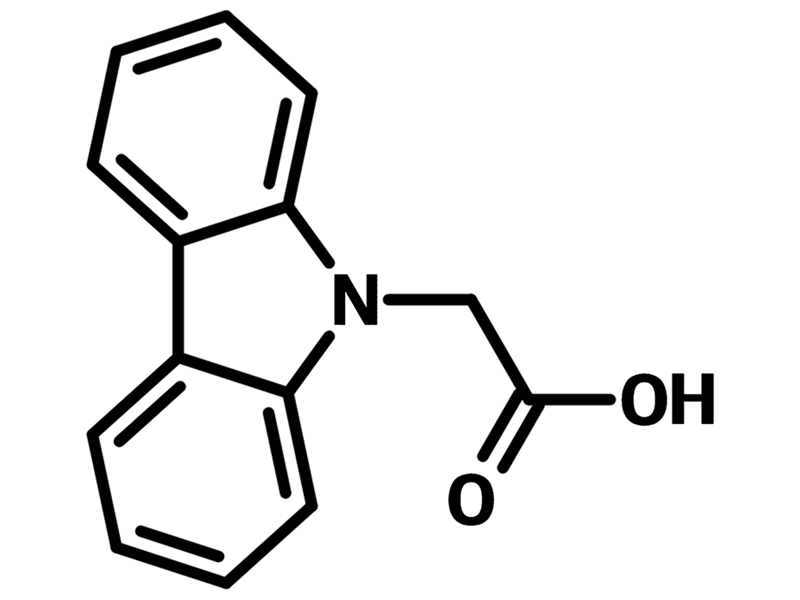9CAA
CAS Number 524-80-1
Charge Transport Layer Materials, Materials, OLED Materials, Perovskite Interface Materials, Perovskite Materials, Self-Assembled Monolayers (SAMs),Small Self-Assembled Monolayer Molecule for High Efficiency Solar Cells
9CAA, Hole transport or extraction layer for NFA-polymer solar cells and p-i-n perovskite solar cells
9CAA (2-(9H-Carbazol-9-yl)acetic acid, CAS No. 524-80-1) consists of a carbazole function group with an acetic acid attached at 9-position. As a self-assembled monolayer material for photovoltaic solar cells, the carboxylic acid serves as the anchoring group to the electrode surface, methylene (-CH2-) as the immediate relatively short spacer, and carbazole as the terminal.
Apart from phosphonic acid, carboxylic acid anchor has also been widely used in tin-lead (Sn-Pb) perovskite solar cells (PSCs) to form self-assembled monolayers to boost device performance and operational stability. In the case of Sn-Pb perovskite solar cells, the monolayer formed by the carboxylate anchoring group shows greater interaction on the interface and has a more favourable orientation and arrangement than the monolayer interface formed by phosphate anchoring group. It also leads to reduced nonradiative recombination and enhanced crystallinity in perovskite active materials by employing 9CAA as the self-assembled monolayer interface contact.
Based on 9CAA as the hole selective contact interface and narrow bandgap (~ 1.25 eV) Sn–Pb perovskite active layer, PSCs demonstrated efficiencies of up to 23.1% with an open-circuit voltage of up to 0.89 V. Moreover, 93% of their initial efficiency was retained for the unencapsulated devices after storage in N2 atmosphere for over 2500 h.
Serving as hole selective contact for organic solar cells and perovskite solar cells, 9CAA is an alternative to PEDOT:PSS with superior performance with the convenience of solution deposition at low concentration, i.e. 1 mM.
Solution Processing Procedure
Typical processing solvents: Ethanol, methanol, IPA, DMF, THF
Typical concentration: 1 mM - 1.0 mg/ml
Typical processing procedure:
9CAA is dissolved in ethanol with a concentration of 0.3 mg/mL. The 9CAA solution is spin-coated on FTO for 30 s at the speed of 3000 rpm, and then annealed for 10 min at 100 ℃ (DOI 10.1002/adma.202312264).
General Information
| CAS Number | 524-80-1 |
|---|---|
| Chemical Formula | C14H11NO2 |
| Molecular Weight | 225.24 g/mol |
| Absorption* | λmax (n.a.) |
| Fluorescence | λem (n.a.) |
| HOMO/LUMO | 5.35 eV (WF FTO) |
| Synonyms | Carbazol-9-yl-acetic acid, 2-(9H-Carbazol-9-yl)acetic acid, CzAA |
| Classification or Family | Carbazole derivatives, Self-assembly Monolayers, Hole transport layer, Hole extraction layer, p-i-n Perovskite solar cells, Organic photovoltaics |
Product Details
| Purity | > 98% (HPLC) |
|---|---|
| Melting Point | 191-194 °C |
| Appearance | White powder/crystals |
Chemical Structure

MSDS Documentation
Literature and Reviews
- Z. Zhang et al. (2024); Anchoring Charge Selective Self-Assembled Monolayers for Tin–Lead Perovskite Solar Cells, Adv. Mater., 36 (18), 2312264; DOI: 10.1002/adma.202312264.
Licensed by Helmholtz-Zentrum Berlin für Materialien und Energie GmbH in Germany and Kaunas University of Technology in Lithuania.

 9CAA MSDS Sheet
9CAA MSDS Sheet